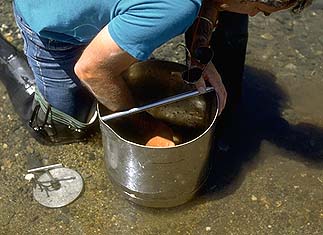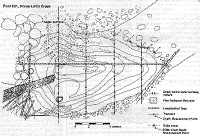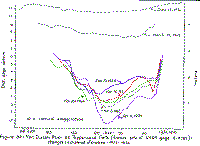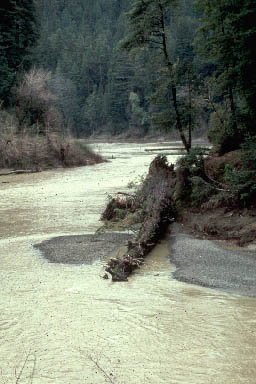Bibliography Background About KRIS
Measuring Sediment in Streams
The amount of fine sediment in the streambed can be measured to determine suitability for salmon and steelhead spawning and rearing (McNeil and Ahnell, 1964). Long-term monitoring can help identify trends in sediment supply and movement through a stream system. If used correctly, these tools can be used to make sure that habitat is recovering.
Fine Sediment in Spawning Gravels
 McNeil samples are often used to determine the composition of stream gravel (McNeil and Ahnell, 1964). They are usually taken at riffle crests, in the type of substrate and flow conditions salmon choose for spawning. For McNeil samples, the standard technique, a coring cylinder is pushed into the stream bed and a sample of the gravel is extracted. The sample is then washed through a series of sieves, which vary in size from 32.0mm to 0.125mm. The finest particles (less than 0.125) are then collected with filter paper cones. The volume of material collected by each sieve is measured and the percent composition of each particle size range is calculated. There may be substantial differences between results of wet sieve sampling and samples which are dry sieved. Shovel samples may be used instead of a core sampler and similar results obtained if collection methods are appropriate (Hames et al., 1996).
McNeil samples are often used to determine the composition of stream gravel (McNeil and Ahnell, 1964). They are usually taken at riffle crests, in the type of substrate and flow conditions salmon choose for spawning. For McNeil samples, the standard technique, a coring cylinder is pushed into the stream bed and a sample of the gravel is extracted. The sample is then washed through a series of sieves, which vary in size from 32.0mm to 0.125mm. The finest particles (less than 0.125) are then collected with filter paper cones. The volume of material collected by each sieve is measured and the percent composition of each particle size range is calculated. There may be substantial differences between results of wet sieve sampling and samples which are dry sieved. Shovel samples may be used instead of a core sampler and similar results obtained if collection methods are appropriate (Hames et al., 1996).
Gravel Permeability
Gravel permeability, dissolved oxygen, and gravel particle size composition are parameters affecting the survival of incubating salmonid embryos. Dissolved oxygen in the interstitial spaces of stream gravels can be measured using a standpipe (Barnard and McBain, 1994). This provides an opportunity to associate local gravel permeability and dissolved oxygen concentrations with physical substrate characteristics, including particle size distribution and vertical stratification. Chapman (1988) showed that survival of eggs and alevin was positively correlated to permeability. Barnard and McBain (1994) found that for "permeabilities greater than 10,000 cm/hr, embryo survival was greater than 85 percent; however, considerable scatter exists for permeabilities lower than 10,000 cm/hr". McBain and Trush (2000) noted that the relationship between permeability and salmonid egg survival is not well understood and concluded that permeability "should only be considered an index of gravel quality, and predictions of salmonid reproductive success are tentative."
Fine sediment in pools
The amount of fine sediment in pools can be quantified using the V* method developed by the U.S. Forest Service Redwood Sciences Laboratory. V* is the amount of fine sediment in a pool relative to the total volume of fine sediment and water. A tape measure is run up the middle of the pool, and perpendicular transects are selected along the entire length of the pool. A stainless steel probe is used to measure the depth of fine sediment along the transect. Ten pools, a valid sample, can be measured by a trained crew in just one day, yielding statistically rich data. Therefore, V* is an ideal monitoring tool for determining if fine sediment is increasing or decreasing in response to land management or restoration efforts. V*, however, should not be used in steep, confined reaches (such as Rosgen A channel types) but rather should be used in reaches with milder gradients (Rosgen B2, B3, or C channel types). One variable of note when using V* is that different amounts of pressure on the probe may result in penetration of the bed to several depths. This may indicate multiple armor layers from previous disturbance regimes, such as early logging.
 Pool #21, Horse Linto Creek, showing location of the longitudinal tape, transects, measurement points for water and fine sediment depth, the riffle crest, and measurement points for riffle crest depth. From Hilton, Sue; Lisle, Thomas E. 1993. Measuring the fraction of pool volume filled with fine sediment . Res. Note PSW-RN-414. Albany, CA: Pacific Southwest Research Station, Forest Service, U.S. Department of Agriculture; 11 p.
Pool #21, Horse Linto Creek, showing location of the longitudinal tape, transects, measurement points for water and fine sediment depth, the riffle crest, and measurement points for riffle crest depth. From Hilton, Sue; Lisle, Thomas E. 1993. Measuring the fraction of pool volume filled with fine sediment . Res. Note PSW-RN-414. Albany, CA: Pacific Southwest Research Station, Forest Service, U.S. Department of Agriculture; 11 p.
Stream cross sections 
Cross sections taken over time show changes in streambed elevation and shape. This tool can provide an indication of whether large amounts of sediment are being transported by a stream. The cross section at left of the Van Duzen River shows major changes in bed elevation related to increased sediment transport. The lowest streambed elevation measured was in 1954. A huge change occurred in years after 1964. The stream bed was buried in 10 to 12 feet of bedload in 1965 and the stream continued to aggrade through 1976. EPA will be re-measuring this site as part of the Van Duzen TMDL.
Turbidity
 Turbidity is a change in the optical property of water which causes light to be scattered and absorbed as opposed to transmitted in straight lines (APHA, 1980). Turbidity may be caused by suspended sediments such as silts or clays, fine particulate organic material or microorganisms such as plankton. Increased turbidities can be injurious to fish and aquatic life, particularly if conditions of high turbidity persist for a long duration (Newcombe and MacDonald, 1991). Effects on fish range from avoidance of highly turbid areas and reduced growth to direct mortality (Bisson and Bilby, 1982; Sigler et al., 1984, Cordone and Kelly, 1961).
Turbidity is a change in the optical property of water which causes light to be scattered and absorbed as opposed to transmitted in straight lines (APHA, 1980). Turbidity may be caused by suspended sediments such as silts or clays, fine particulate organic material or microorganisms such as plankton. Increased turbidities can be injurious to fish and aquatic life, particularly if conditions of high turbidity persist for a long duration (Newcombe and MacDonald, 1991). Effects on fish range from avoidance of highly turbid areas and reduced growth to direct mortality (Bisson and Bilby, 1982; Sigler et al., 1984, Cordone and Kelly, 1961).
Reid (personal communication), in a recent study of Humboldt County streams, found a high correlation between elevated turbidities and high road densities and widespread, recent timber harvesting. Models based on the field data indicate that in disturbed watersheds, streams experience turbidities greater than 100 nephlometric turbidity units (NTU) for two to three months a year, whereas streams in undisturbed watersheds have such high NYU readings only two or three days in a three year period.
Holtby et al. (1990) found that ocean survival rates decrease for coho salmon as the size of out-migrating smolts decreases. Sigler et al. (1984) found that growth of steelhead and coho salmon juveniles was retarded when turbidity chronically exceeded 25 ntu. It is possible that increased turbidity could be a major limiting factor for coho salmon growth and survival. High turbidity is also associated with scouring of algae which grows on rocks and decreased survival of aquatic insects. The TMDL report for the Noyo River (EPA, 1999) did not set targets for turbidity because of a lack of baseline data. Turbidity standards have been set by some states, such as Alaska, where an increase of no more than 5 NTU above background is allowed for drinking water sources and not more than 25 NTU over background for other streams (Lloyd, 1987).
References
Barnard, K. and S. McBain. 1994. Using a Standpipe to Determine Permeability, Dissolved Oxygen, and Vertical Particle Size Distribution in Salmonid Spawning Gravels. As FHR Currents # 15. US Forest Service, Region 5. Eureka, CA. 12 pp.
Bisson, P. A. and R.E. Bilby. 1982. Avoidance of suspended sediment by juvenile coho salmon. North American Journal of Fisheries Management. 2 (4):371-374.
Chapman. D.W. 1988. Critical Review of Variables Used to Define Effects of Fines in Redds of Large Salmonids. Transactions of the American Fisheries Society. 117: 1-21.
Cordone, A.J. and D.W. Kelly. 1961. The influence of sediment on aquatic life in streams. California Department of Fish and Game Journal. 47:1047-1080.
Hames, D.S., B. Conrad, A. Pleus and D. Smith. 1996 . TFW Ambient Monitoring Program Report: Field comparison of the McNeil sampler with three shovel-based methods used to sample spawning substrate composition in small streams. Northwest Indian Fisheries Commission. May 1996.
Holtby, L.B., B.C. Andersen and R.K. Kadowski. 1990. Importance of smolt size and early ocean growth to inter-annual variability of marine survival of coho salmon (Oncorhynchus kisutch). Canadian Journal of Fisheries and Aquatic Sciences. Vol 4.
Lloyd, D.S. 1987. Turbidity as a water quality standard for salmonid habitats in Alaska. North American Journal of Fisheries Management. 7(1):33-45.
Lotspeich, F.B. and F.H. Everest. 1980. A new method for reporting and interpreting textural composition of spawning gravel. U.S. Forest Service Research Note: PNW-139.
Newcombe, C.P. and D.D. MacDonald. 1991. Effects of suspended sediment on aquatic ecosystems. North American Journal of Fisheries Management. 11: 72-82.
McBain and Trush. 2000. Spawning gravel composition and permeability within the Garcia River watershed, CA. Final Report. Prepared for Mendocino County Resource Conservation District. 32 pages without appendices.
McNeil, W. J. and W.H. Ahnell. 1964.Success of Pink Spawning Relative to Size of Spawning Bed Material. U.S. Fish and Wildlife Service, Special Scientific Report—Fisheries No. 469. Washington, D.C. 17 pp.
Reid, Leslie. Personal communication. U.S.F.S. Redwood Sciences Lab, Arcata, CA.
Sigler, J.W., T.C. Bjornn and F.H. Everst. 1984. Effects of Chronic Turbidity on Density and Growth of Steelhead and Coho Salmon. Transactions of the American Fisheries Society. 113:142-150.
